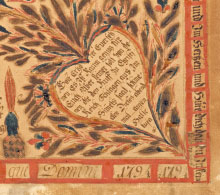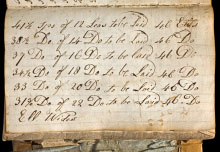

What Our Historians Do
Documents, Data, and Context
Historians comb through historical documents to discover the thoughts and actions of the men, women, and children who populated Williamsburg in the past. We work with archaeologists, architectural historians, curators, tradespeople, and interpreters to improve our understanding of the past and to shape the experience of visitors to the Historic Area.
Documents
Letters, diaries, account books, and other writings help us understand the experiences and thoughts of individuals from the past. Some sources reveal the thinking behind patriots' political arguments, while others offer a glimpse into family life and marriage.
Data
From government records, ledgers, and newspapers, researchers track how things like populations and prices changed over time. From this, we can learn about how people were living—what their income was, what it could buy, what they spent it on, and where people decided to live.
Context
Primary research in archives combines with broader knowledge about the history of Virginia, the colonies, the Revolution, and the Early Republic. This allows our historians to see how Williamsburg fit into the bigger picture—how it was unique some ways, but similar to other colonies in others.
